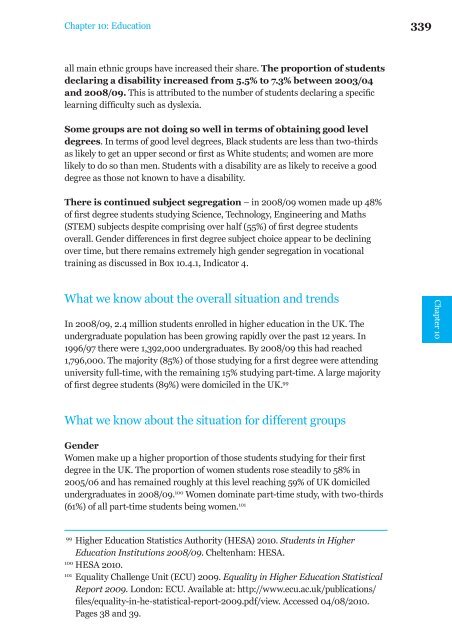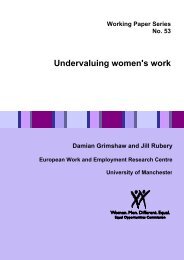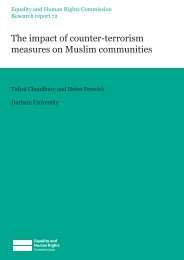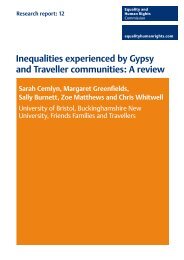Chapter 10: Education - Equality and Human Rights Commission
Chapter 10: Education - Equality and Human Rights Commission
Chapter 10: Education - Equality and Human Rights Commission
Create successful ePaper yourself
Turn your PDF publications into a flip-book with our unique Google optimized e-Paper software.
<strong>Chapter</strong> <strong>10</strong>: <strong>Education</strong> 339<br />
all main ethnic groups have increased their share. The proportion of students<br />
declaring a disability increased from 5.5% to 7.3% between 2003/04<br />
<strong>and</strong> 2008/09. This is attributed to the number of students declaring a specific<br />
learning difficulty such as dyslexia.<br />
Some groups are not doing so well in terms of obtaining good level<br />
degrees. In terms of good level degrees, Black students are less than two-thirds<br />
as likely to get an upper second or first as White students; <strong>and</strong> women are more<br />
likely to do so than men. Students with a disability are as likely to receive a good<br />
degree as those not known to have a disability.<br />
There is continued subject segregation – in 2008/09 women made up 48%<br />
of first degree students studying Science, Technology, Engineering <strong>and</strong> Maths<br />
(STEM) subjects despite comprising over half (55%) of first degree students<br />
overall. Gender differences in first degree subject choice appear to be declining<br />
over time, but there remains extremely high gender segregation in vocational<br />
training as discussed in Box <strong>10</strong>.4.1, Indicator 4.<br />
What we know about the overall situation <strong>and</strong> trends<br />
In 2008/09, 2.4 million students enrolled in higher education in the UK. The<br />
undergraduate population has been growing rapidly over the past 12 years. In<br />
1996/97 there were 1,392,000 undergraduates. By 2008/09 this had reached<br />
1,796,000. The majority (85%) of those studying for a first degree were attending<br />
university full-time, with the remaining 15% studying part-time. A large majority<br />
of first degree students (89%) were domiciled in the UK. 99<br />
<strong>Chapter</strong> <strong>10</strong><br />
What we know about the situation for different groups<br />
Gender<br />
Women make up a higher proportion of those students studying for their first<br />
degree in the UK. The proportion of women students rose steadily to 58% in<br />
2005/06 <strong>and</strong> has remained roughly at this level reaching 59% of UK domiciled<br />
undergraduates in 2008/09. <strong>10</strong>0 Women dominate part-time study, with two-thirds<br />
(61%) of all part-time students being women. <strong>10</strong>1<br />
99<br />
Higher <strong>Education</strong> Statistics Authority (HESA) 20<strong>10</strong>. Students in Higher<br />
<strong>Education</strong> Institutions 2008/09. Cheltenham: HESA.<br />
<strong>10</strong>0<br />
HESA 20<strong>10</strong>.<br />
<strong>10</strong>1<br />
<strong>Equality</strong> Challenge Unit (ECU) 2009. <strong>Equality</strong> in Higher <strong>Education</strong> Statistical<br />
Report 2009. London: ECU. Available at: http://www.ecu.ac.uk/publications/<br />
files/equality-in-he-statistical-report-2009.pdf/view. Accessed 04/08/20<strong>10</strong>.<br />
Pages 38 <strong>and</strong> 39.












